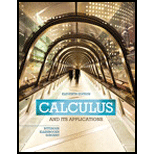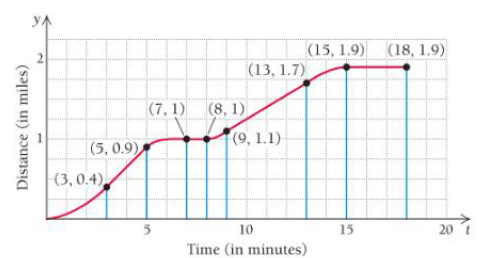
Concept explainers
For Exercises 55-58, consider the growth of

In what open interval(s) is the Jogger running at a constant speed?
Want to see the full answer?
Check out a sample textbook solution
Chapter 1 Solutions
Calculus and Its Applications (11th Edition)
Additional Math Textbook Solutions
Precalculus (10th Edition)
Calculus, Single Variable: Early Transcendentals (3rd Edition)
Thomas' Calculus: Early Transcendentals (14th Edition)
Precalculus Enhanced with Graphing Utilities (7th Edition)
Calculus: Early Transcendentals (3rd Edition)
Glencoe Math Accelerated, Student Edition
- What is the y -intercept on the graph of the logistic model given in the previous exercise?arrow_forwardThe population P (in millions) of Texas from 2001 through 2014 can be approximated by the model P=20.913e0.0184t, where t represents the year, with t=1 corresponding to 2001. According to this model, when will the population reach 32 million?arrow_forwardRepeat the previous exercise to find the formula forthe APY of an account that compounds daily. Usethe results from this and the previous exercise todevelop a function I(n)for the APY of any accountthat compounds n times per year.arrow_forward
- Assume that an object tossed vertically upward reaches a height of h feet after t seconds, where h=100t16t2. What is that maximum height?arrow_forwardFor the following exercise, consider this scenario: In 2004, a school population was 1,700. By 2012 the population had grown to 2,500. Assume the population is changing linearly. a. How much did the population grow between the year 2004 and 2012? b. What is the average population growth per year? c. Find an equation for the population, P, of the school t years after 2004.arrow_forwardWhat is the composition of two functions, fg ?arrow_forward
- Table 6 shows the population, in thousands, of harbor seals in the Wadden Sea over the years 1997 to 2012. a. Let x represent time in years starting with x=0 for the year 1997. Let y represent the number of seals in thousands. Use logistic regression to fit a model to these data. b. Use the model to predict the seal population for the year 2020. c. To the nearest whole number, what is the limiting value of this model?arrow_forwardTable 2 shows a recent graduate’s credit card balance each month after graduation. a. Use exponential regression to fit a model to these data. b. If spending continues at this rate, what will the graduate’s credit card debt be one year after graduating?arrow_forwardFor the following exercises, use the graph in Figure 3, showing the profit, y, in thousands of dollars, of a company in a given year, x, where x represents years since 1980. In 2004, a school population was 1250. By 2012 the population had dropped to 875. Assume the population is changing linearly. a. How much did the population drop between the year 2004 and 2012? b. What is the average population decline per year? c. Find an equation for the population, P, of the school t years after 2004.arrow_forward
- A particle is traveling along the x-axis so that its position at all times x(t) is given by the function x(t)=e(¹-2)-½t². At what times is the particle slowing down? A. (2.000, ∞ ) only B. (3.146, ∞o) only C. (0,0.159) and (2.000, 3.146) D. (0.159, 2.000) and (3.146, ∞ ) E. (0,0.159) and (3.146, ∞ )arrow_forwardIn this model, the period immediately after the stock is issued offers excess returns on the stock—that is, the stock is selling for more than it is really worth. One such model for a class of Internet IPOs predicts the percent overvaluation of a stock as a function of time as R(t)=250(t2/(2.718)3t) where R (t) is the overvaluation in percent and t is the time in months after the initial issue. a. Use the information provided by the first derivative, second derivative, and asymptotes to prepare advice for clients as to when they should expect a signal to prepare to buy or sell (inflection point), the exact time when they should buy or sell (local maximum and minimum), and any false signals prior to a horizontal asymptote. Explain your reasoning. please type answer.arrow_forwardShow detailsarrow_forward
 Algebra & Trigonometry with Analytic GeometryAlgebraISBN:9781133382119Author:SwokowskiPublisher:Cengage
Algebra & Trigonometry with Analytic GeometryAlgebraISBN:9781133382119Author:SwokowskiPublisher:Cengage Algebra and Trigonometry (MindTap Course List)AlgebraISBN:9781305071742Author:James Stewart, Lothar Redlin, Saleem WatsonPublisher:Cengage Learning
Algebra and Trigonometry (MindTap Course List)AlgebraISBN:9781305071742Author:James Stewart, Lothar Redlin, Saleem WatsonPublisher:Cengage Learning Glencoe Algebra 1, Student Edition, 9780079039897...AlgebraISBN:9780079039897Author:CarterPublisher:McGraw Hill
Glencoe Algebra 1, Student Edition, 9780079039897...AlgebraISBN:9780079039897Author:CarterPublisher:McGraw Hill
 Big Ideas Math A Bridge To Success Algebra 1: Stu...AlgebraISBN:9781680331141Author:HOUGHTON MIFFLIN HARCOURTPublisher:Houghton Mifflin Harcourt
Big Ideas Math A Bridge To Success Algebra 1: Stu...AlgebraISBN:9781680331141Author:HOUGHTON MIFFLIN HARCOURTPublisher:Houghton Mifflin Harcourt





